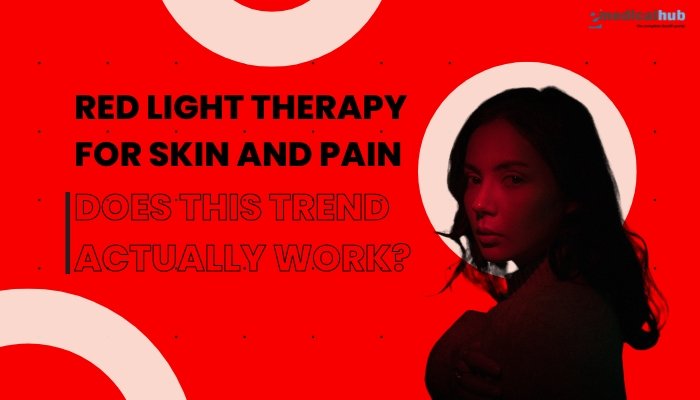Introduction
Red light therapy (RLT) has emerged as a popular treatment modality in recent years, touted as a non-invasive solution for skin rejuvenation, pain relief, and overall wellness. Often marketed as a cutting-edge, at-home treatment, RLT uses low-level wavelengths of red or near-infrared light to stimulate cellular repair and reduce inflammation. Proponents claim that it can improve skin texture, reduce wrinkles, accelerate wound healing, and alleviate joint and muscle pain. But does the science support these claims? Is red light therapy a breakthrough in natural healing or just another wellness trend with minimal benefits?
This article examines the mechanisms behind red light therapy, reviews the scientific evidence for its use in skin care and pain management, discusses potential risks and practical guidelines, and helps you decide if this treatment is right for you. Whether you are curious about improving your skin’s appearance or seeking relief from chronic pain, read on to explore what red light therapy can—and cannot—do.
Disclaimer: The information provided in this article is for educational purposes only and does not substitute for personalized medical advice. If you are considering red light therapy, particularly if you have underlying medical conditions, please consult a qualified healthcare provider.
Understanding Red Light Therapy
What Is Red Light Therapy?
Red light therapy involves exposing the skin to low levels of red or near-infrared light. Unlike ultraviolet light, which can damage the skin, red light is non-ionizing and is considered safe for therapeutic use.
- Wavelengths: Typically between 600 and 1000 nanometers (nm). Red light (around 630-700 nm) primarily targets skin issues, while near-infrared (around 800-880 nm) penetrates deeper to affect muscles and joints.
- Delivery Methods: Can be administered in clinical settings, at wellness centers, or via at-home devices such as panels, handheld devices, or LED masks.
- Mechanism: The light is absorbed by mitochondria in cells, stimulating energy production (ATP) and initiating cellular repair processes.
Historical Background
- Early Research: Although modern RLT devices are relatively new, the use of light for healing dates back centuries. Ancient cultures, including the Egyptians and Greeks, utilized sunlight for therapeutic purposes.
- Modern Developments: Advances in LED technology in the late 20th century made controlled red light therapy feasible. Clinical research over the past two decades has provided insights into its potential benefits for skin and musculoskeletal conditions.
- Growing Popularity: Celebrity endorsements and social media have accelerated the trend, making RLT accessible to a broad audience.
Mechanisms of Action
Red light therapy is thought to work through several interrelated biological mechanisms:
Cellular Energy Production
- Mitochondrial Stimulation: The absorption of red light by mitochondrial chromophores enhances ATP production, fueling cellular repair and regeneration.
- Enhanced Cell Function: Increased energy availability helps cells repair damaged tissue, promote collagen production, and reduce inflammation.
Anti-Inflammatory Effects
- Cytokine Modulation: RLT may reduce pro-inflammatory cytokines and increase anti-inflammatory mediators, leading to decreased inflammation and pain.
- Improved Blood Flow: The therapy promotes vasodilation, enhancing circulation and supporting tissue repair.
Collagen Synthesis and Skin Rejuvenation
- Stimulation of Fibroblasts: Red light can boost the activity of fibroblasts, cells responsible for collagen production, leading to improved skin elasticity and reduced wrinkles.
- Wound Healing: Enhanced collagen production and cellular repair accelerate wound healing and reduce scar formation.
Pain Modulation
- Nerve Function: RLT may help modulate pain signals by affecting nerve conduction, reducing the sensation of pain in muscles and joints.
- Muscle Recovery: By lowering inflammation and promoting cellular repair, red light therapy can speed up recovery from muscle strain and overuse injuries.
Benefits of Red Light Therapy
Skin Health
Red light therapy is widely used in dermatology and cosmetic applications for its skin benefits:
- Anti-Aging: Improves skin texture, reduces fine lines and wrinkles, and enhances overall skin tone.
- Acne and Inflammation: Helps reduce acne-related inflammation and promotes clearer skin.
- Wound Healing and Scar Reduction: Accelerates healing of minor wounds and may improve the appearance of scars.
- Psoriasis and Eczema: Some evidence suggests that RLT can help alleviate symptoms of inflammatory skin conditions.
Pain Relief
For those suffering from chronic pain or muscle soreness, red light therapy offers potential relief:
- Joint Pain: May reduce pain and stiffness associated with osteoarthritis and rheumatoid arthritis.
- Muscle Recovery: Helps diminish delayed onset muscle soreness (DOMS) after intense workouts.
- Back and Neck Pain: Can be applied to alleviate tension and discomfort in these common problem areas.
- Neuropathic Pain: Preliminary studies indicate potential benefits for nerve-related pain, although further research is needed.
Overall Wellness and Recovery
- Improved Circulation: Enhanced blood flow can support overall cardiovascular health.
- Enhanced Immune Function: By reducing inflammation and promoting cellular repair, RLT may indirectly boost the immune system.
- Mental Well-Being: Some users report a sense of increased vitality and reduced stress following regular sessions.
Scientific Evidence: What Research Tells Us
Skin Rejuvenation Studies
Clinical trials in dermatology have demonstrated that red light therapy can significantly improve skin appearance:
- Collagen Production: Studies show increased collagen synthesis, leading to improved skin elasticity and reduced wrinkle depth.
- Inflammation Reduction: Research indicates that RLT decreases inflammatory markers in the skin, contributing to a smoother, clearer complexion.
Pain and Inflammation Research
Evidence for pain relief and anti-inflammatory effects includes:
- Arthritis Management: Several trials have reported reductions in pain and improvements in joint function in patients with osteoarthritis.
- Muscle Recovery: Research on athletes demonstrates that post-exercise red light therapy can reduce muscle soreness and improve recovery time.
- Neuropathic and Chronic Pain: Some small-scale studies have observed benefits in reducing chronic pain levels, though more research is needed for conclusive results.
Limitations and Inconsistencies
- Variability in Protocols: Differences in wavelengths, treatment durations, and device types contribute to inconsistent outcomes.
- Placebo Effect: Some studies note improvements in both treatment and control groups, suggesting that placebo effects may play a role.
- Long-Term Data: Most research focuses on short-term benefits, and more long-term studies are needed to establish sustained efficacy.
Practical Considerations for Using Red Light Therapy
Selecting a Device
When considering red light therapy, choose a device that meets your needs:
- Type of Device: Options include LED panels, handheld devices, and LED masks. Panels are ideal for full-body treatments, while masks are suited for facial skin care.
- Wavelength and Intensity: Look for devices that emit wavelengths in the therapeutic range (typically 630-700 nm for red light and 800-880 nm for near-infrared).
- Quality and Safety: Ensure the device is certified and meets safety standards. Read reviews and check for third-party testing.
Setting Up Your Treatment
- Duration: Sessions typically last 10-20 minutes. Start with shorter sessions if you are new to the therapy.
- Distance: Follow manufacturer guidelines on how far the device should be from your body.
- Frequency: Most experts recommend 3-5 sessions per week, though this can be adjusted based on individual response and treatment goals.
- Consistency: Regular, repeated sessions are key to seeing long-term benefits.
Integrating into a Daily Routine
- At-Home Use: Many devices are designed for personal use, allowing you to integrate red light therapy into your daily routine without needing to visit a clinic.
- Combination Therapies: Consider combining RLT with other treatments—such as skincare routines for anti-aging benefits or physical therapy for pain management—to maximize results.
- Monitoring Progress: Keep a journal to track changes in skin appearance, pain levels, and overall well-being over time.
Potential Risks and Safety Concerns
Skin Sensitivity
- Mild Irritation: Some users may experience temporary redness or irritation, particularly if the device is used too close or for too long.
- Photosensitivity: If you are taking medications that increase light sensitivity, consult your doctor before using red light therapy.
Eye Safety
- Protective Eyewear: Although red light is generally safe, prolonged exposure to high-intensity light can strain your eyes. Use protective goggles if recommended by the manufacturer.
Contraindications
- Pregnancy: While red light therapy is considered safe by many practitioners, pregnant women should consult their healthcare provider.
- Certain Medical Conditions: People with photosensitive conditions or certain skin disorders should use caution.
- Device Quality: Poorly manufactured devices may not deliver consistent wavelengths or could pose electrical or safety risks. Always choose high-quality, reputable products.
Comparing Red Light Therapy to Other Treatments
Table: Red Light Therapy vs. Traditional Treatments
| Aspect | Red Light Therapy | Topical Creams | Oral Supplements |
| Mechanism | Stimulates cellular repair via light absorption | Delivers active ingredients directly to the skin | Provides nutrients systemically |
| Onset of Effects | Gradual improvement over weeks | Variable; immediate to several weeks | Several weeks to months |
| Invasiveness | Non-invasive; no pain or needles | Non-invasive | Non-invasive |
| Side Effects | Minimal if used correctly; possible skin irritation | May cause allergic reactions | Potential gastrointestinal upset |
| Cost | Moderate to high (initial investment in device) | Generally lower | Varies by formulation |
| Ease of Use | Requires set-up and adherence to protocols | Easy; apply as needed | Easy; follow dosage instructions |
Advantages and Disadvantages
- Advantages:
- Non-invasive and drug-free.
- Can be used in the comfort of your home.
- Versatile applications for skin, pain, and recovery.
- Disadvantages:
- High initial cost for quality devices.
- Requires consistent use over time.
- Mixed research results with some placebo influence.
Real-World Experiences and Case Studies
Skin Rejuvenation
A 45-year-old woman reported noticeable improvements in skin texture, reduced fine lines, and an overall “glow” after 8 weeks of using an LED panel at home. She followed a protocol of 15-minute sessions, five times per week, and combined the treatment with her regular skincare routine.
Pain Management
An amateur athlete experiencing chronic knee pain after intensive training incorporated red light therapy into his recovery plan. Over a period of 6 weeks, he noted reduced joint stiffness and improved mobility, allowing him to train more effectively without relying heavily on anti-inflammatory medications.
Overall Well-Being
A middle-aged individual with moderate inflammation and fatigue tried red light therapy as part of a broader wellness routine. After 4 weeks of regular sessions, the individual reported increased energy levels, reduced stress, and improved sleep quality, attributing these benefits to both the physical and mental effects of the therapy.
Frequently Asked Questions (FAQ)
- What is red light therapy and how does it work?
Red light therapy uses low-level wavelengths of red or near-infrared light to stimulate cellular energy production and promote healing, reducing inflammation and supporting skin repair. - How long does it take to see results from red light therapy?
While some individuals may notice improvements in mood and energy shortly after starting, significant benefits for skin rejuvenation and pain relief typically appear after 4 to 8 weeks of consistent use. - Is red light therapy safe?
Generally, red light therapy is considered safe when used as directed. However, potential risks include skin irritation and eye strain, so proper device usage and protective eyewear are recommended. - How often should I use a red light therapy device?
Most protocols suggest using the device 3-5 times per week for 10-20 minute sessions, though this can vary depending on individual needs and device specifications. - Can red light therapy help with acne and other skin conditions?
Many studies indicate that red light therapy can improve skin conditions by reducing inflammation and promoting collagen production, thereby improving acne, wrinkles, and overall skin texture. - Is red light therapy effective for chronic pain?
Research suggests that red light therapy may reduce pain and inflammation in conditions such as osteoarthritis, muscle soreness, and joint pain, though individual responses can vary. - Do I need a prescription to use red light therapy?
No, red light therapy devices are available for over-the-counter use. However, it is advisable to consult with a healthcare provider if you have any underlying medical conditions. - What should I look for when purchasing a red light therapy device?
Choose a device that delivers wavelengths in the therapeutic range (630-700 nm for red light and 800-880 nm for near-infrared), has good reviews, and is produced by a reputable manufacturer with safety certifications. - Can I combine red light therapy with other treatments?
Yes, red light therapy is often used as a complementary treatment alongside topical creams, oral supplements, and physical therapies for enhanced overall benefits. - How does red light therapy compare to traditional anti-aging treatments?
Red light therapy offers a non-invasive alternative that stimulates natural collagen production and cellular repair, whereas traditional treatments like chemical peels or laser therapy may be more invasive and require longer recovery times. - Are there any contraindications for using red light therapy?
Individuals with photosensitive conditions or those taking photosensitizing medications should use caution. Always follow device guidelines and consult a healthcare provider if you have concerns. - Can I use red light therapy at home?
Absolutely. Many high-quality devices are designed for home use, allowing you to incorporate red light therapy into your daily routine with minimal hassle.
Conclusion
Red light therapy represents an innovative, non-invasive approach to improving skin health and alleviating pain. By harnessing the power of low-level red and near-infrared light, this therapy stimulates cellular energy production, enhances collagen synthesis, and reduces inflammation—benefits that can translate into smoother skin, reduced signs of aging, and relief from chronic pain. While scientific research supports many of these claims, results can vary depending on individual factors, device quality, and treatment protocols.
For those considering red light therapy, it is essential to use high-quality, well-reviewed devices and adhere to recommended guidelines regarding duration and frequency. Integrating red light therapy into a broader wellness regimen—complemented by a healthy diet, regular exercise, and proper skincare—can maximize its benefits and contribute to overall health and vitality.
Ultimately, red light therapy may not be a magic bullet, but it offers a promising, natural option for enhancing skin appearance and managing pain. With careful, consistent use and realistic expectations, this emerging trend could become a valuable part of your long-term health strategy.




